The Evolution of International Scientific Collaboration in Fuel Cells during 1998–2017: A Social Network Perspective
Abstract
:1. Introduction
- What is the distribution status of the international scientific collaboration intensity of fuel cell?
- What are the characteristics of international collaboration development of fuel cells among countries?
- How does the international scientific collaboration of fuel cells change over time? And how to cluster among countries?
- How does the main research areas of the international scientific collaboration of fuel cells evolve?
2. Materials and Methods
2.1. Data
2.2. Methods
- Nodes refer to countries in the co-authoring network. Number of nodes represents the absolute scale of the network during a focused time interval.
- Neighbor nodes refer to the nodes that directly connected to the target node. Number of neighbor nodes represents the scale of the scientific collaboration of a focused node.
- Average node degree is defined as the sum of neighbor nodes per node in the network divided by the total number of nodes, which represents the average number of partners per node in the overall network.
- Links refer to the co-authoring relationship between the connected countries. Number of links represents the number of connections among all nodes in the whole network. For a single node, this measure indicates the sum of connections between the focused node and its neighbor nodes.
- Average link strength is defined as the total number of connections among all nodes in the network divided by the number of existing pairs of nodes in the network. For a given node, it refers to the average number of connections between the target node and each of its neighbor nodes in the network, which indicates the average collaborative frequency of a country with its partner countries.
- Density is defined as the number of existing pairs of nodes divided by the number of all potential pairs of nodes, which evaluates the extensiveness and evolutionary trend of partnership in the overall international collaboration network.
- Centrality indicates the position of a country in the international collaboration network. Three centrality measures—degree centrality, betweenness centrality and closeness centrality—are used in our analysis. Degree centrality refers to the total number of connections between the focused node and other nodes, which reflects the node’s popularity by accessing more information from other nodes. Betweenness centrality is the frequency that the focused node lies on the shortest paths between other pairs of nodes, which reflects the node’s ability to control the information. Closeness centrality is the sum of the distances between focused nodes and all other nodes in a network, which reflects its ability to obtain and disseminating information.
- Clustering coefficient is a measure of the probability that any two neighbors of a mutual node are connected. When the entire network has a high clustering coefficient, it has a tendency to form cliques. As for nodes, a higher clustering coefficient indicates that the node has a higher tendency to form cliques.
- Average path length refers to the mean of the shortest paths between all pairs of nodes, which measures the overall connectedness of the network and also the network efficiency.
3. Results
3.1. General Trends of Fuel Cell International Collaboration
3.2. Network Analysis of Fuel Cell International Collaboration
3.2.1. Network Distribution
3.2.2. Characteristics of Countries
3.2.3. Evolution of Networks
3.3. Degree of International Collaboration at Country Level
3.4. Semantic Term Maps of Fuel Cell International Research Areas
4. Conclusions
Author Contributions
Funding
Conflicts of Interest
Appendix A
| Time Interval | Country | Neigh. Nodes | Aver. Link Strength | Entropy | Clus. Coeff. | DC | BC | CC |
|---|---|---|---|---|---|---|---|---|
| 2013–2017 | USA | 80 | 49.06 | 7.39 | 0.34 | 3925 | 611.16 | 75.97 |
| UK | 71 | 24.52 | 26.15 | 0.39 | 1741 | 560.12 | 71.78 | |
| Germany | 70 | 25.97 | 22.86 | 0.41 | 1818 | 368.59 | 71.34 | |
| China | 68 | 60.9 | 7.66 | 0.42 | 4141 | 563.37 | 70.48 | |
| France | 65 | 22.97 | 22.33 | 0.42 | 1493 | 791.55 | 69.23 | |
| Spain | 65 | 16.2 | 21.77 | 0.44 | 1053 | 353.15 | 69.23 | |
| Italy | 61 | 18.21 | 15.83 | 0.49 | 1111 | 170.9 | 67.63 | |
| South Korea | 61 | 20.97 | 8.85 | 0.44 | 1279 | 362.49 | 67.24 | |
| Japan | 60 | 21.03 | 10.54 | 0.47 | 1262 | 402.06 | 66.86 | |
| India | 58 | 11.95 | 16.6 | 0.5 | 693 | 251.83 | 66.48 | |
| 2008–2012 | USA | 69 | 32.03 | 11.25 | 0.27 | 2210 | 828.1 | 79 |
| Germany | 57 | 17.81 | 19.67 | 0.36 | 1015 | 367.56 | 71.76 | |
| France | 57 | 15.77 | 19.35 | 0.35 | 899 | 498.47 | 71.76 | |
| Japan | 54 | 13.3 | 10.21 | 0.39 | 718 | 348.14 | 69.63 | |
| UK | 50 | 14.62 | 27.59 | 0.44 | 731 | 239.32 | 68.12 | |
| Canada | 49 | 11.76 | 8.56 | 0.42 | 576 | 230.13 | 67.14 | |
| China | 46 | 37.87 | 7.8 | 0.48 | 1742 | 229.55 | 66.2 | |
| Italy | 45 | 13.27 | 13.32 | 0.47 | 597 | 113.84 | 65.73 | |
| Spain | 44 | 10.59 | 16.45 | 0.44 | 466 | 165.42 | 64.83 | |
| India | 39 | 6.79 | 12.27 | 0.53 | 265 | 164.34 | 62.67 | |
| 2003–2007 | USA | 49 | 13.65 | 16.6 | 0.25 | 669 | 514.74 | 74.75 |
| Germany | 46 | 8.3 | 18.52 | 0.28 | 382 | 394.37 | 72.55 | |
| UK | 41 | 6.66 | 24.75 | 0.31 | 273 | 354.03 | 69.16 | |
| France | 38 | 6.89 | 13.85 | 0.34 | 262 | 277.92 | 67.27 | |
| Japan | 34 | 7.03 | 10.03 | 0.39 | 239 | 226.16 | 63.79 | |
| Canada | 34 | 6.35 | 7.93 | 0.38 | 216 | 128.07 | 64.35 | |
| Italy | 28 | 5.64 | 9.85 | 0.44 | 158 | 80.9 | 60.66 | |
| Spain | 26 | 5.81 | 13.25 | 0.42 | 151 | 117.38 | 59.68 | |
| Sweden | 26 | 4.73 | 12.99 | 0.5 | 123 | 76.26 | 59.68 | |
| Greece | 25 | 2.72 | 8.06 | 0.45 | 68 | 108.25 | 58.73 | |
| 1998–2002 | Germany | 27 | 4.59 | 19.97 | 0.27 | 124 | 245.27 | 69.01 |
| USA | 25 | 4.12 | 15.67 | 0.31 | 103 | 171.2 | 67.12 | |
| France | 23 | 2.74 | 9.85 | 0.27 | 63 | 218.54 | 62.82 | |
| UK | 22 | 2.55 | 15.52 | 0.33 | 56 | 169.8 | 62.82 | |
| Japan | 19 | 3.05 | 11.07 | 0.43 | 58 | 63.02 | 59.04 | |
| Italy | 17 | 2.82 | 9.6 | 0.43 | 48 | 45.53 | 56.98 | |
| India | 14 | 2.57 | 10.62 | 0.51 | 36 | 31.57 | 56.32 | |
| Netherlands | 14 | 2.07 | 8.85 | 0.41 | 29 | 42.5 | 56.32 | |
| Denmark | 13 | 2.15 | 10.05 | 0.41 | 28 | 73.25 | 53.26 | |
| China | 12 | 2.83 | 4.59 | 0.44 | 34 | 82.69 | 53.85 |
| Country | Entropy | Countries (% Int. Pub.) of Origin of Co-Authors | Domestic and Foreign Institutions of Affiliation of Co-Authors |
|---|---|---|---|
| USA | 9.48 | China (32.9%); South Korea (12%); Canada (7%); Japan (7%); Germany (6.5%) | Georgia Inst Technol (4.9%); Penn State Univ (4.6%); Chinese Acad Sci (4.1%); Univ S Carolina (3%); MIT (2.8%) |
| China | 8.04 | USA (35.2%); Australia (10%); Japan (8.9%); UK (8%); Canada (7.5%) | Chinese Acad Sci (13.3%); Harbin Inst Technol (5.1%); Nanyang Technol Univ (5.1%); Tsinghua Univ (4.7%); Univ Sci Technol China (4.6%) |
| Germany | 22.07 | USA (15.4%); China (11.4%); France (11%); UK (7.5%); Italy (7%) | Forschungszentrum Julich (11.7%); Tech Univ Munich (4.8%); Tech Univ Berlin (4%); Karlsruhe Inst Technol (3.3%); Univ Stuttgart (3.3%) |
| UK | 28.23 | China (19.7%); USA (14.9%); Germany (8.5%); Spain (8.2%); Italy (6.8%) | Univ London Imperial Coll Sci Technol Med (11.7%); Univ ST Andrews (8.3%); Univ Birmingham (6%); Univ Cambridge (6%); Newcastle Univ (5.3%) |
| France | 20.56 | Germany (13.7%); Italy (13.4%); USA (12.3%); Spain (10%); China (5.3%) | CNRS (8.4%); Univ Poitiers (7.6%); Univ Grenoble Alpes (4.2%); CSIC (3.8%); Univ Montpellier 2 (3.3%) |
| Japan | 10.66 | China (26%); USA (21.6%); South Korea (10%); Australia (6.2%); UK (5.4%) | Natl Inst Mat Sci (10.2%); Kyushu Univ (8.5%); Tohoku Univ (8.1%); Univ Tokyo (6.9%); Natl Inst Adv Ind Sci Technol (6.2%) |
| South Korea | 6.9 | USA (41.3%); China (16%); Japan (11%); India (8.9%); UK (5.8%) | Chonbuk Natl Univ (8.5%); Korea Inst Sci Technol (7.3%); Korea Adv Inst Sci Technol (6.6%); Seoul Natl Univ (6.3%); Hanyang Univ (5.6%) |
| Canada | 9.69 | China (25.5%); USA (25.2%); Germany (6.5%); UK (5.7%); France (5.4%) | Natl Res Council Canada (14.5%); Univ Waterloo (10.8%); Univ British Columbia (7.6%); Univ Alberta (7%); Simon Fraser Univ (4.8%) |
| Italy | 14.87 | USA (20.5%); France (19%); Germany (12.3%); UK (10.4%); Spain (8.6%) | CNR (10.1%); Univ Roma Tor Vergata (9.5%); Univ Genoa (8%); Politecn Milan (6.5%); Univ Padua (6.3%) |
| Spain | 19.92 | France (15.9%); UK (14.3%); Germany (11.6%); USA (10.6%); Italy (9.7%) | CSIC (24.9%); Univ La Laguna (5.6%); Univ Barcelona (5%); Univ Alicante (4.2%); Univ Politecn Valencia (4.2%) |
| Australia | 5.86 | China (49.8%); USA (11.1%); Japan (10.5%); UK (7.6%); Singapore (7.3%) | Univ Queensland (23.2%); Curtin Univ (19.3%); Monash Univ (10.2%); Nanyang Technol Univ (7%); Univ New S Wales (6.3%) |
| India | 15.29 | USA (19.6%); South Korea (17.2%); Germany (9.6%); Japan (9.3%); UK (8%) | Indian Inst Technol (16.8%); Indian Inst Sci (4.4%); Anna Univ (4.1%); Chonbuk Natl Univ (3.9%); Madurai Kamaraj Univ (3.9%) |
| Singapore | 4.59 | China (54.7%); Australia (11.7%); USA (11.1%); UK (7.3%); South Korea (4.4%) | Nanyang Technol Univ (65%); Natl Univ Singapore (27.6%); Chinese Acad Sci (6.6%); Astar (4.7%); Sun Yat Sen Univ (4%) |
| Sweden | 13.41 | China (32.7%); Finland (9.3%); Germany (8.7%); UK (8.7%); Pakistan (8.6%) | Lund Univ (19.5%); Royal Inst Technol (19.5%); Chalmers (14.3%); Royal Inst Technol KTH (10.9%); Hubei Univ (8.2%) |
| Switzerland | 13.56 | Germany (24.9%); USA (20.9%); France (10.6%); Italy (10%); Denmark (8%) | Paul Scherrer Inst (26.8%); Ecole Polytech Fed Lausanne (22.8%); ETH (16.7%); Swiss Fed Inst Technol (9.1%); EMPA (7.4%) |
| Russia | 13.54 | Germany (26.9%); France (17.8%); USA (13.1%); Greece (8.8%); UK (7.3%) | Russian Acad Sci (29.9%); Moscow Mv Lomonosov State Univ (18.6%); Boreskov Inst Catalysis (7%); Forschungszentrum Julich (7%); Univ Thessaly (6.5%) |
| Denmark | 14.89 | USA (19.8%); Germany (19.1%); China (15.1%); Sweden (9%); Switzerland (8.7%) | Tech Univ Denmark (56.8%); Aalborg Univ (8.5%); Univ Copenhagen (7.3%); Riso Natl Lab (6%); Aarhus Univ (4.7%) |
| Taiwan | 5.93 | China (36.3%); USA (28.4%); India (6.8%); Canada (6.6%); Japan (4.6%) | Natl Taiwan Univ (19.2%); Natl Cheng Kung Univ (12%); Natl Taiwan Univ Sci Technol (11.8%); Yuan Ze Univ (10.3%); Natl Taipei Univ Technol (6.5%) |
| Brazil | 12.41 | France (17.7%); USA (15.2%); Italy (13.2%); Germany (11%); Spain (8.6%) | Univ Sao Paulo (30%); Scuola Sci Mat (6.2%); Univ Poitiers (5.6%); Univ Fed Santa Catarina (4.5%); Ipen Cnen Sp (4.3%) |
| Netherlands | 17.29 | Germany (22.6%); USA (13.6%); UK (12%); Italy (10.6%); France (10.4%) | Delft Univ Technol (22.8%); Univ Twente (10%); Eindhoven Univ Technol (9.4%); Wageningen Univ (6.8%); Leiden Univ (6.4%) |
| Saudi Arabia | 14.65 | Egypt (19.4%); USA (18.4%); China (17.2%); South Korea (14.5%); Japan (9.3%) | King Saud Univ (26.2%); King Abdulaziz Univ (20.8%); King Abdullah Univ Sci Technol (12.5%); Chonbuk Natl Univ (7.4%); Menia Univ (7.4%) |
| Portugal | 16.4 | Spain (21.7%); Germany (12.9%); USA (9.6%); Russia (9.3%); Byelarus (8.5%) | Univ Aveiro (44.7%); Univ Porto (16.8%); CSIC (9.8%); Univ Lisbon (7.2%); Belarusian State Univ (6.2%) |
| Iran | 11.78 | USA (24.8%); Canada (16.8%); Malaysia (14.7%); South Korea (8%); Switzerland (7.2%) | Islamic Azad Univ (13%); Amirkabir Univ Technol (12%); Univ Tehran (9.3%); Tarbiat Modares Univ (7.2%); Univ Teknol Malaysia (6.7%) |
| Poland | 17.58 | Germany (15.5%); Italy (14.4%); USA (14.4%); France (12.5%); Japan (12%) | Agh Univ Sci Technol (21.5%); Polish Acad Sci (16.6%); Warsaw Univ Technol (12.5%); Univ Warsaw (11.7%); Gdansk Univ Technol (10%) |
| Belgium | 16.68 | China (19.3%); France (17.3%); Australia (14.6%); USA (14.6%); Germany (10.7%) | Univ Ghent (29.5%); Katholieke Univ Leuven (14%); Univ Queensland (12%); Univ Liege (7.7%); Univ Antwerp (7.4%) |
References
- Sustainable Innovation Forum 2017. Available online: http://www.cop-23.org/ (accessed on 1 November 2018).
- Cropper, M.A.J.; Geiger, S.; Jollie, D.M. Fuel cells: A survey of current developments. J. Power Sources 2004, 131, 57–61. [Google Scholar] [CrossRef]
- Karim, N.A.; Kamarudin, S.K. An overview on non-platinum cathode catalysts for direct methanol fuel cell. Appl. Energy 2013, 103, 212–220. [Google Scholar] [CrossRef]
- Andújar, J.M.; Segura, F. Fuel cells: History and updating. A walk along two centuries. Renew. Sustain. Energy Rev. 2009, 13, 2309–2322. [Google Scholar] [CrossRef]
- Ahmad, M.M.; Kamarudin, S.K.; Daud, W.R.W.; Yaakub, Z. High power passive μDMFC with low catalyst loading for small power generation. Energy Convers. Manag. 2010, 51, 821–825. [Google Scholar] [CrossRef]
- Basri, S.; Kamarudin, S.K. Process system engineering in direct methanol fuel cell. Int. J. Hydrogen Energy 2011, 36, 6219–6236. [Google Scholar] [CrossRef]
- Sharaf, O.Z.; Orhan, M.F. An overview of fuel cell technology: Fundamentals and applications. Renew. Sustain. Energy Rev. 2014, 32, 810–853. [Google Scholar] [CrossRef]
- Das, V.; Padmanaban, S.; Venkitusamy, K.; Selvamuthukumaran, R.; Blaabjerg, F.; Siano, P. Recent advances and challenges of fuel cell based power system architectures and control—A review. Renew. Sustain. Energy Rev. 2017, 73, 10–18. [Google Scholar] [CrossRef]
- Manganote, E.J.T.; Araujo, M.S.; Schulz, P.A. Visualization of ranking data: Geographical signatures in international collaboration, leadership and research impact. J. Informetr. 2014, 8, 642–649. [Google Scholar] [CrossRef]
- Coccia, M.; Wang, L. Evolution and convergence of the patterns of international scientific collaboration. Proc. Natl. Acad. Sci. USA 2016, 113, 2057–2061. [Google Scholar] [CrossRef]
- Dawes, S.S.; Gharawi, M.A.; Burke, G.B. Transnational public sector knowledge networks: Knowledge and information sharing in a multi-dimensional context. Gov. Inf. Q. 2012, 29, 112–120. [Google Scholar] [CrossRef]
- Kim, K.W. Measuring international research collaboration of peripheral countries: Taking the context into consideration. Scientometrics 2006, 66, 231–240. [Google Scholar] [CrossRef]
- Hagedoorn, J.; Link, A.N.; Vonortas, N.S. Research partnerships1. Res. Policy 2000, 29, 567–586. [Google Scholar] [CrossRef]
- Arunachalam, S.; Viswanathan, B. A historiographic analysis of fuel-cell research in Asia–China racing ahead. Curr. Sci. India 2008, 95, 36–49. [Google Scholar]
- Suominen, A.; Tuominen, A. Analyzing the Direct Methanol Fuel Cell technology in portable applications by a historical and bibliometric analysis. J. Bus. Chem. 2010, 7, 117–130. [Google Scholar]
- Girap, P.; Kumar, A.; Mohan, L.; Surwase, G.; Kademani, B.S. Scientometric dimensions of fuel cell research as reflected in INIS database. SRELS J. Inf. Manag. 2011, 48, 329–348. [Google Scholar]
- Cindrella, L.; Fu, H.Z.; Ho, Y.S. Global thrust on fuel cells and their sustainability–an assessment of research trends by bibliometric analysis. Int. J. Sustain. Energy 2014, 33, 125–140. [Google Scholar] [CrossRef]
- Klitkou, A.; Nygaard, S.; Meyer, M. Tracking techno-science networks: A case study of fuel cells and related hydrogen technology R&D in Norway. Scientometrics 2007, 70, 491–518. [Google Scholar]
- Chen, H.Q.; Wang, X.; He, L.; Chen, P.; Wan, Y.; Yang, L.; Jiang, S. Chinese energy and fuels research priorities and trend: A bibliometric analysis. Renew. Sustain. Energy Rev. 2016, 58, 966–975. [Google Scholar] [CrossRef]
- Suominen, A. Phases of growth in a green tech research network: A bibliometric evaluation of fuel cell technology from 1991 to 2010. Scientometrics 2014, 100, 51–72. [Google Scholar] [CrossRef]
- Ogawa, T.; Takeuchi, M.; Kajikawa, Y. Comprehensive analysis of trends and emerging technologies in all types of fuel cells based on a computational method. Sustainability 2018, 10, 458. [Google Scholar] [CrossRef]
- Luukkonen, T.; Persson, O.; Sivertsen, G. Understanding patterns of international scientific collaboration. Sci. Technol. Hum. Values 1992, 17, 101–126. [Google Scholar] [CrossRef]
- Laudel, G. Collaboration, creativity and rewards: Why and how scientists collaborate. Int. J. Technol. Manag. 2001, 22, 762–781. [Google Scholar] [CrossRef]
- Puuska, H.M.; Muhonen, R.; Leino, Y. International and domestic co-publishing and their citation impact in different disciplines. Scientometrics 2014, 98, 823–839. [Google Scholar] [CrossRef]
- Coccia, M.; Bozeman, B. Allometric models to measure and analyze the evolution of international research collaboration. Scientometrics 2016, 108, 1065–1084. [Google Scholar] [CrossRef]
- Persson, O.; Danell, R.; Schneider, J.W. How to use Bibexcel for various types of bibliometric analysis. In Celebrating Scholarly Communication Studies: A Festschrift for Olle Persson at His 60th Birthday; ISSI: Lund, Sweden, 2009; pp. 9–24. [Google Scholar]
- Glänzel, W. National characteristics in international scientific co-authorship relations. Scientometrics 2001, 51, 69–115. [Google Scholar] [CrossRef]
- Franceschet, M. Collaboration in computer science: A network science approach. J. Am. Soc. Inf. Sci. Technol. 2011, 62, 1992–2012. [Google Scholar] [CrossRef]
- Barnett, G.A.; Park, H.W.; Jiang, K.; Tang, C.; Aguillo, I.F. A multi-level network analysis of web-citations among the world’s universities. Scientometrics 2014, 99, 5–26. [Google Scholar] [CrossRef]
- Kim, J.; Tao, L.; Lee, S.H.; Diesner, J. Evolution and structure of scientific co-publishing network in Korea between 1948–2011. Scientometrics 2016, 107, 27–41. [Google Scholar] [CrossRef]
- Dehdarian, M.A. Three Essays on Methodologies for Dynamic Modeling of Emerging Socio-Technical Systems: The Case of Smart Grid Development. Doctoral Dissertation, Ecole Polytechnique Fédérale de Lausanne, Lausanne, Switzerland, 2017. [Google Scholar]
- Borgatti, S.P.; Everett, M.G.; Freeman, L.C. Ucinet 6 for Windows: Software for Social Network Analysis; Analytic Technologies: Harvard, MA, USA, 2002. [Google Scholar]
- Van Eck, N.; Waltman, L. Software survey: VOSviewer, a computer program for bibliometric mapping. Scientometrics 2009, 84, 523–538. [Google Scholar] [CrossRef]
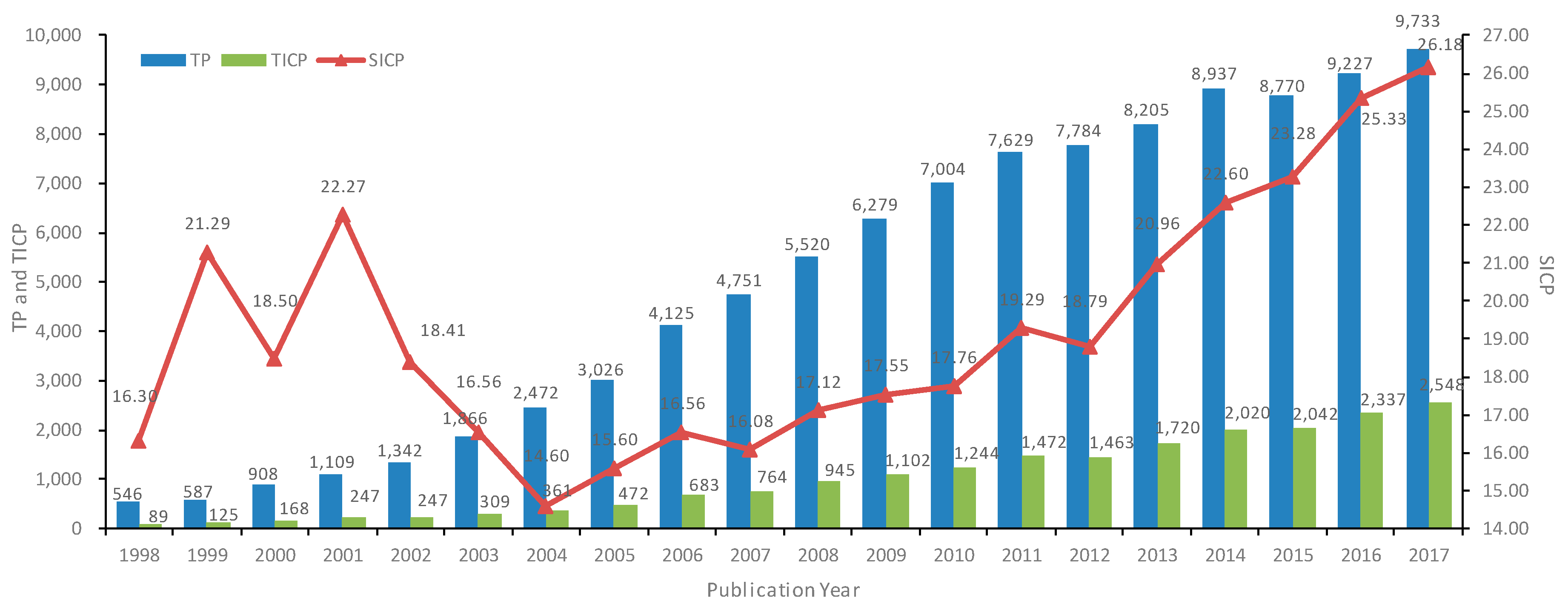
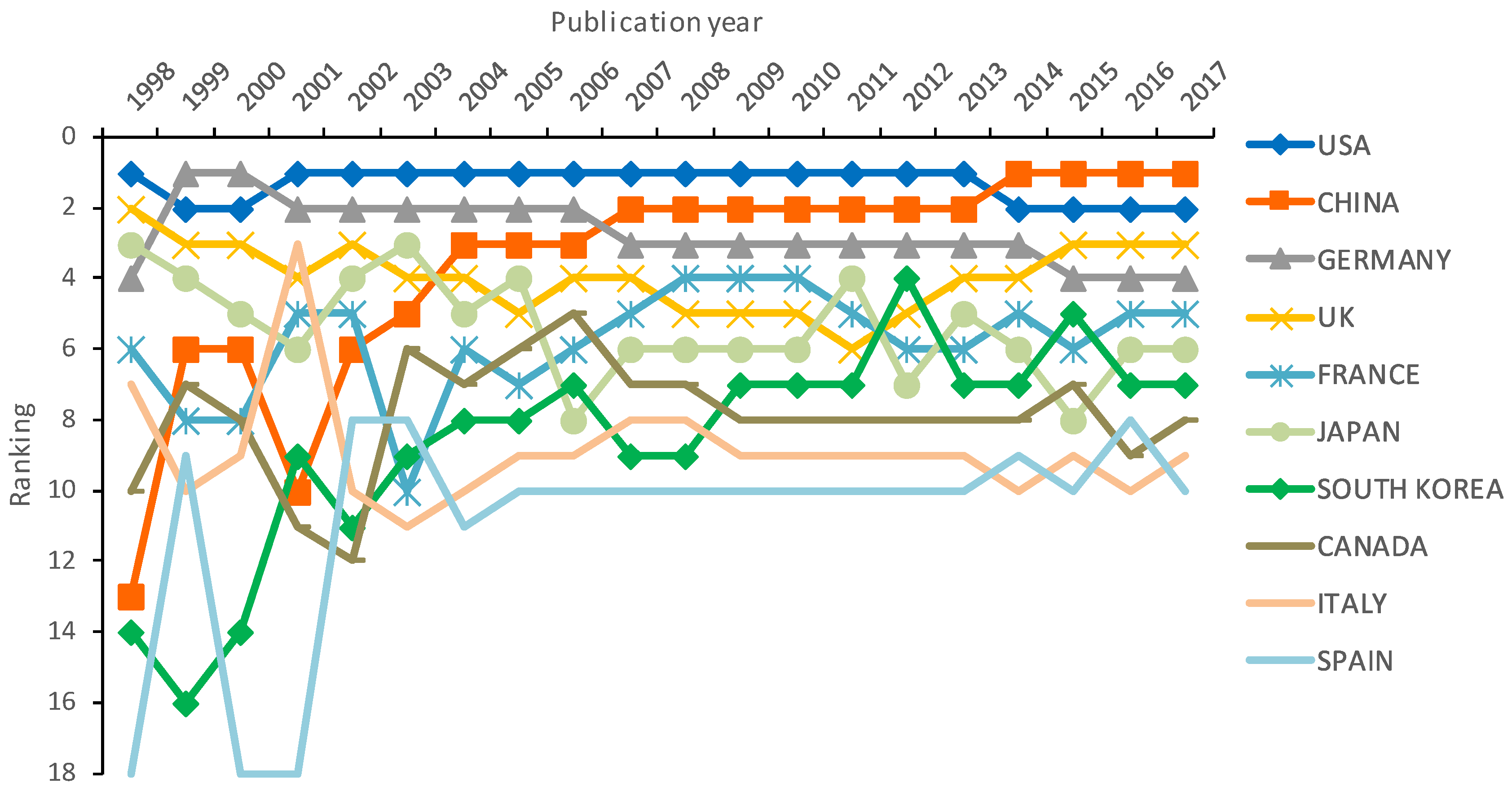
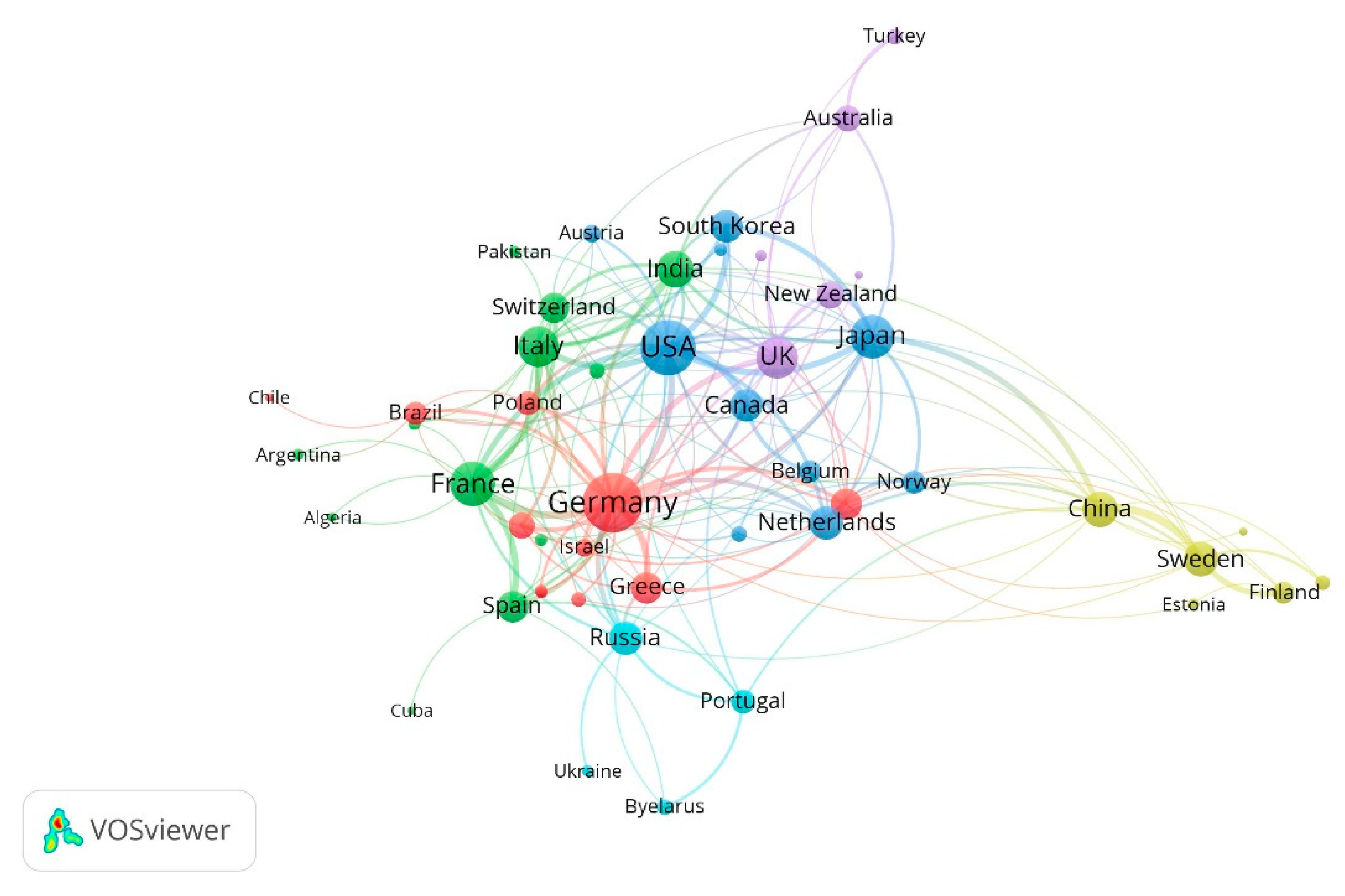

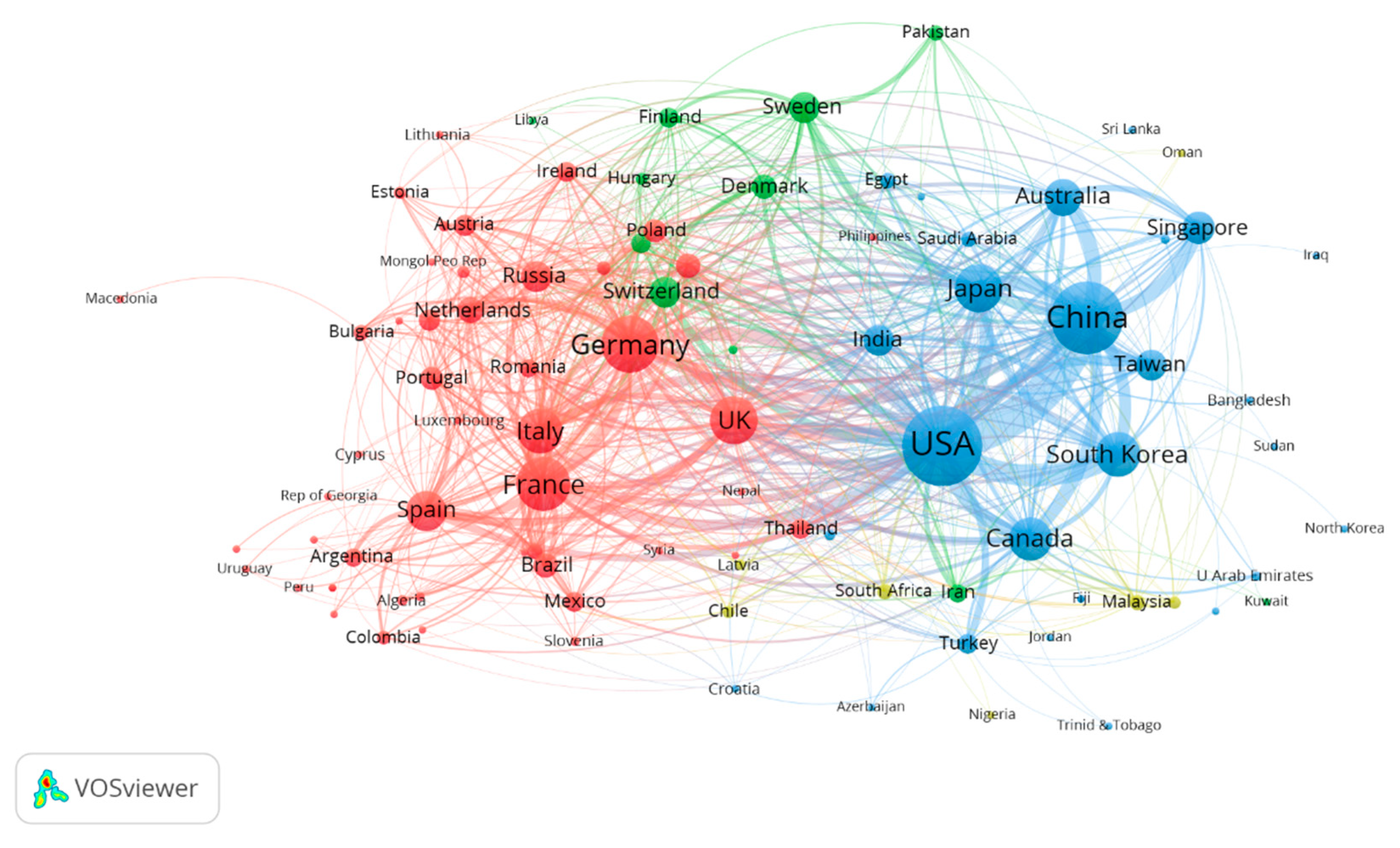
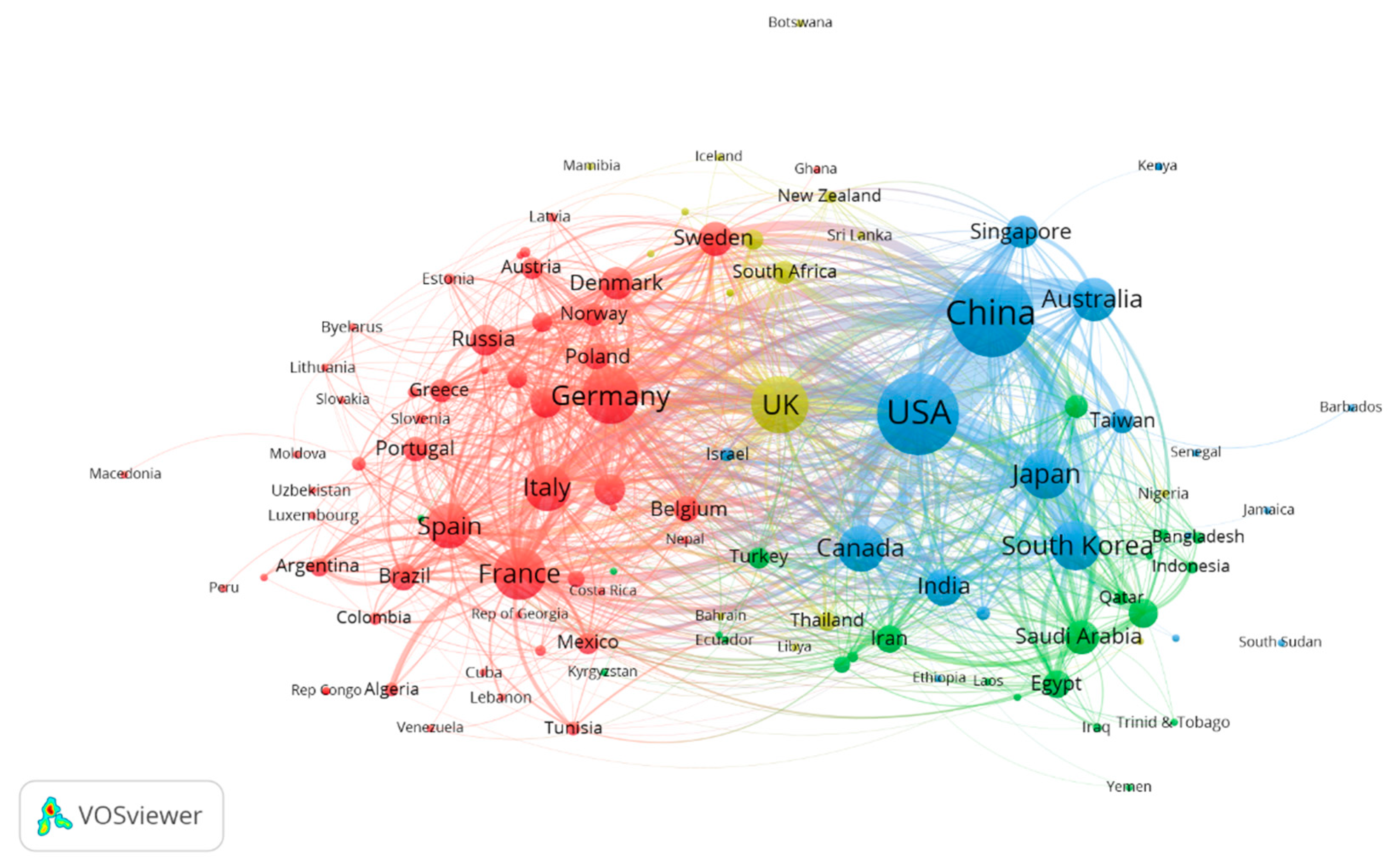



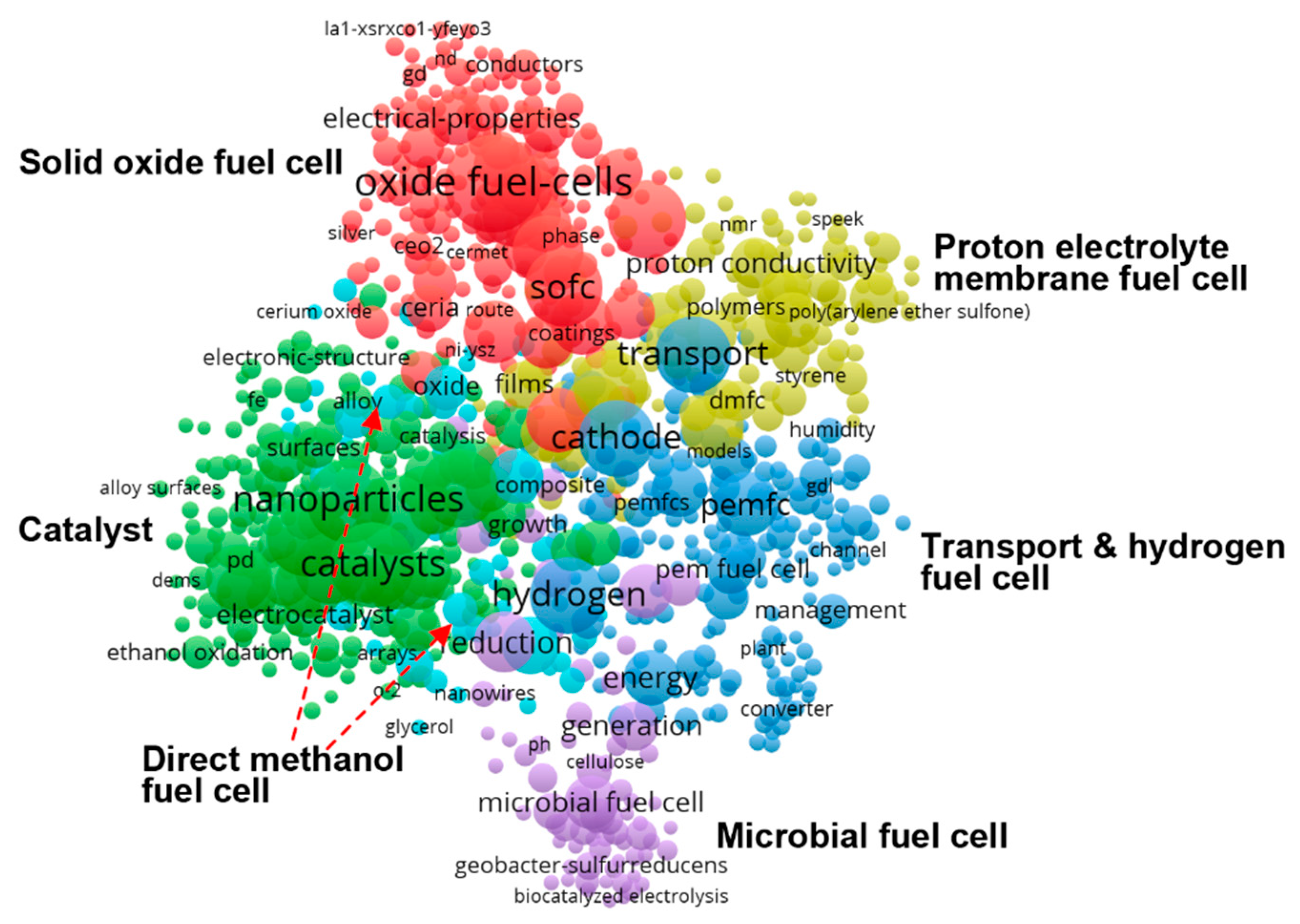
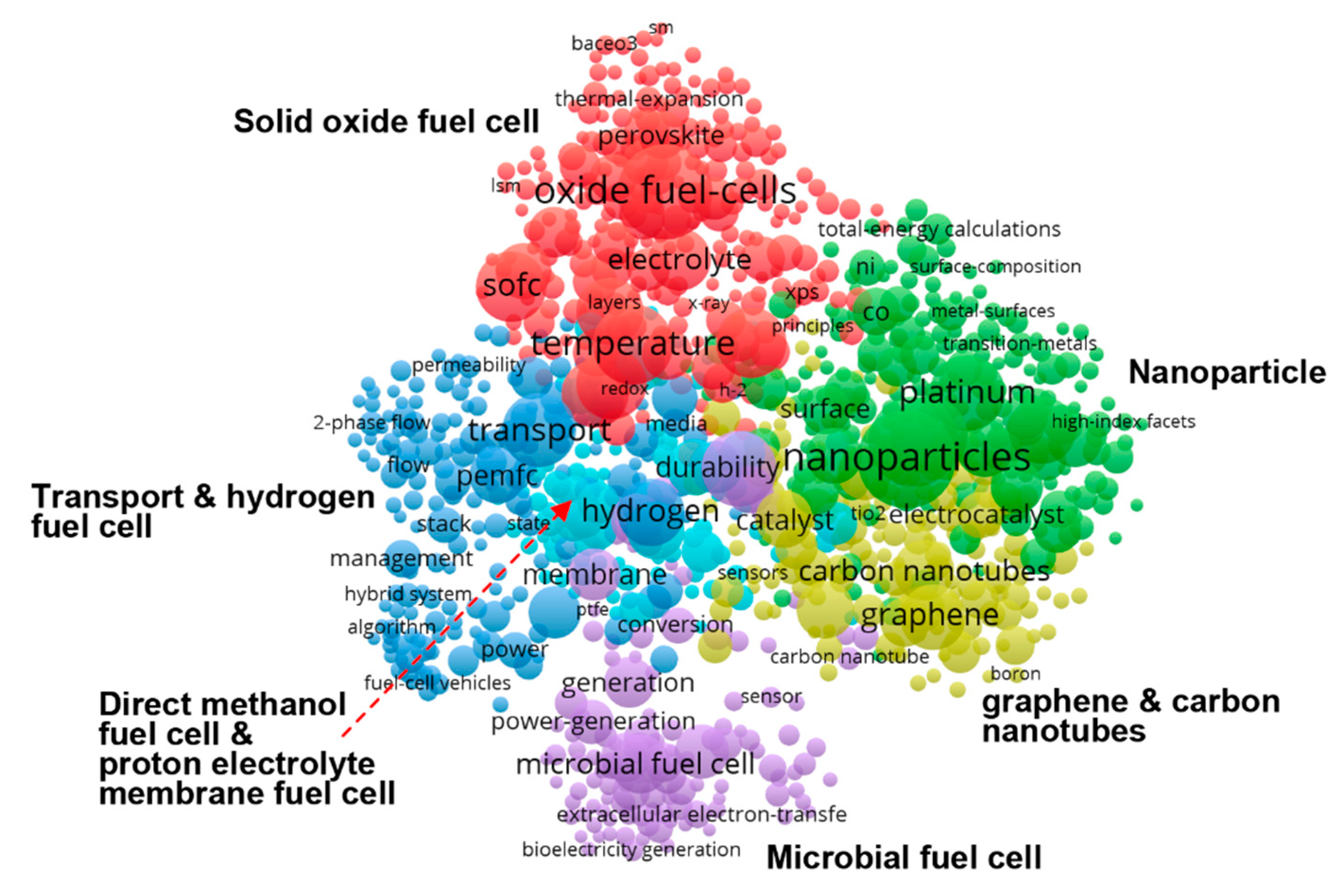
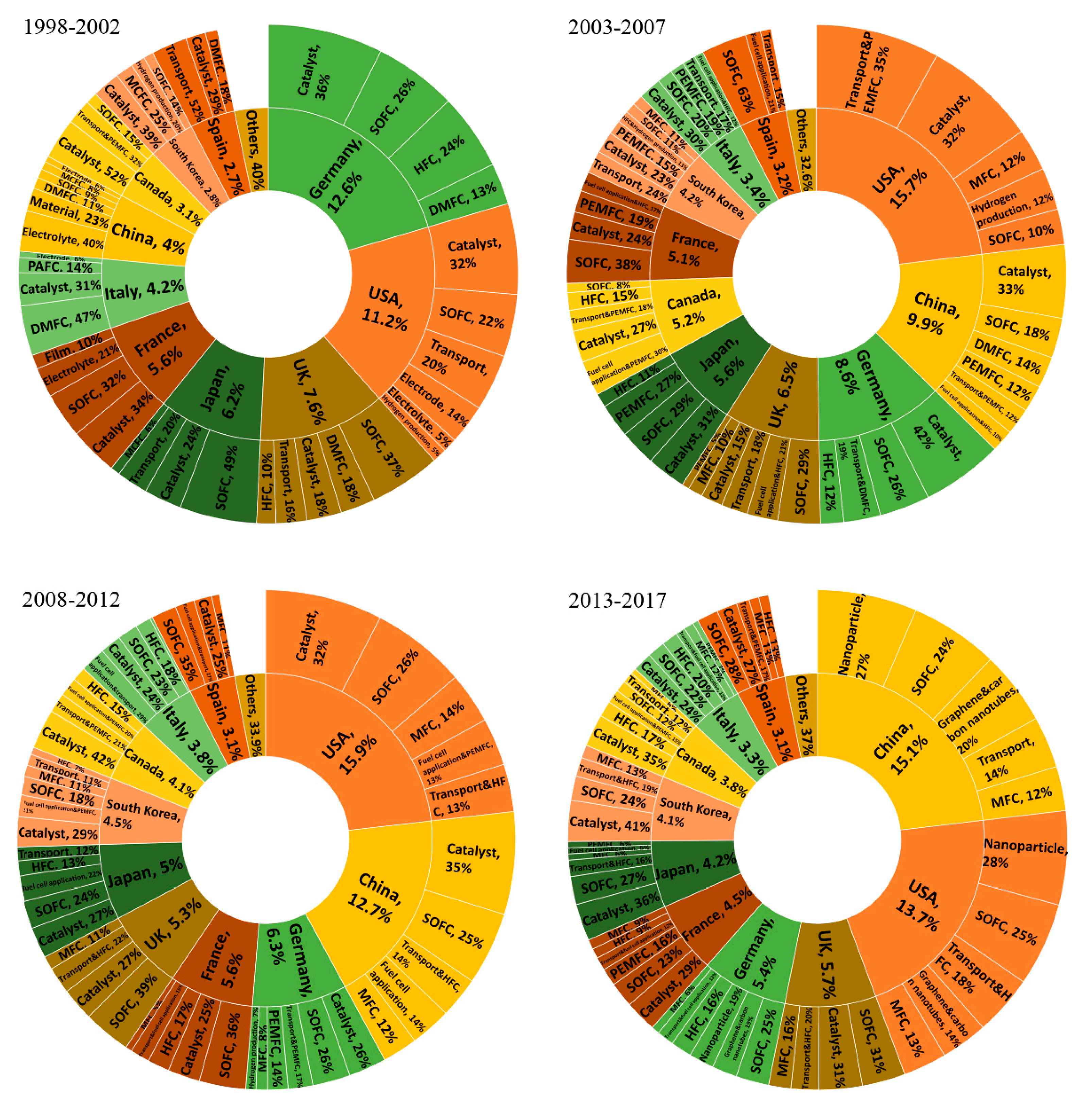
| Year | 1998 | 1999 | 2000 | 2001 | 2002 | 2003 | 2004 | 2005 | 2006 | 2007 |
| TCC | 27 | 32 | 35 | 36 | 44 | 44 | 52 | 53 | 57 | 58 |
| TBR | 39 | 59 | 66 | 73 | 97 | 102 | 147 | 158 | 239 | 235 |
| Year | 2008 | 2009 | 2010 | 2011 | 2012 | 2013 | 2014 | 2015 | 2016 | 2017 |
| TCC | 70 | 75 | 77 | 80 | 76 | 88 | 89 | 97 | 85 | 92 |
| TBR | 295 | 384 | 410 | 438 | 434 | 535 | 594 | 640 | 709 | 778 |
| Year | 1998 | 1999 | 2000 | 2001 | 2002 | 2003 | 2004 | 2005 | 2006 | 2007 |
| Gini | 0.380 | 0.455 | 0.485 | 0.472 | 0.512 | 0.546 | 0.585 | 0.625 | 0.628 | 0.652 |
| Year | 2008 | 2009 | 2010 | 2011 | 2012 | 2013 | 2014 | 2015 | 2016 | 2017 |
| Gini | 0.654 | 0.657 | 0.660 | 0.668 | 0.656 | 0.677 | 0.675 | 0.692 | 0.673 | 0.662 |
| Measure | 1998–2002 | 2003–2007 | 2008–2012 | 2013–2017 |
|---|---|---|---|---|
| Number of nodes | 50 | 75 | 95 | 118 |
| Number of links | 484 | 2244 | 7474 | 15,727 |
| Density | 0.146 | 0.149 | 0.176 | 0.184 |
| Clustering coefficient | 0.650 | 0.713 | 0.739 | 0.770 |
| Average path length | 2.208 | 2.088 | 1.992 | 1.991 |
| Average node degree | 7.160 | 11.040 | 16.589 | 21.576 |
| Average link strength | 2.704 | 5.420 | 9.485 | 12.354 |
© 2018 by the authors. Licensee MDPI, Basel, Switzerland. This article is an open access article distributed under the terms and conditions of the Creative Commons Attribution (CC BY) license (http://creativecommons.org/licenses/by/4.0/).
Share and Cite
Shi, X.; Cai, L.; Jia, J. The Evolution of International Scientific Collaboration in Fuel Cells during 1998–2017: A Social Network Perspective. Sustainability 2018, 10, 4790. https://doi.org/10.3390/su10124790
Shi X, Cai L, Jia J. The Evolution of International Scientific Collaboration in Fuel Cells during 1998–2017: A Social Network Perspective. Sustainability. 2018; 10(12):4790. https://doi.org/10.3390/su10124790
Chicago/Turabian StyleShi, Xuan, Lingfei Cai, and Junzhi Jia. 2018. "The Evolution of International Scientific Collaboration in Fuel Cells during 1998–2017: A Social Network Perspective" Sustainability 10, no. 12: 4790. https://doi.org/10.3390/su10124790





